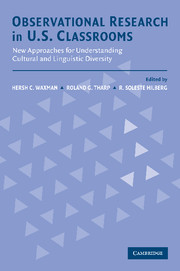 Observational Research in U.S. Classrooms
Observational Research in U.S. Classrooms Book contents
- Frontmatter
- Contents
- Tables, Figures, and Appendixes
- Contributors
- 1 Introduction: Purposes and Perspectives on Classroom Observation Research
- 2 Using Multiple Perspectives in Observations of Diverse Classrooms: The Sheltered Instruction Observation Protocol (SIPO)
- 3 The Standards Performance Continuum: A Performance-Based Measure of the Standards for Effective Pedagogy
- 4 The Uses of the Classroom Observation Schedule to Improve Classroom Instruction
- 5 Development and Use of a Classroom Observation Instrument to Investigate Teaching for Meaning in Diverse Classrooms
- 6 Patterns of Language Arts Instructional Activity and Excellence in First– and Fourth–Grade Culturally and Linguistically Diverse Classrooms
- 7 Using Classroom Observation as a Research and Formative Evaluation Tool in Educational Reform: The School Observation Measure
- 8 Observing School Restructuring in Multilingual, Multicultural Classrooms: Balancing Ethnographic and Evaluative Approaches
- 9 Sociocultural Activity Settings in the Classroom: A Study of a Classroom Observation System
- 10 The Influence of School Reform on Classroom Instruction in Diverse Schools: Findings from an Observational Study of Success for All
- 11 Future Directions for Classroom Observation Research
- Index
- References
3 - The Standards Performance Continuum: A Performance-Based Measure of the Standards for Effective Pedagogy
Published online by Cambridge University Press: 23 November 2009
- Frontmatter
- Contents
- Tables, Figures, and Appendixes
- Contributors
- 1 Introduction: Purposes and Perspectives on Classroom Observation Research
- 2 Using Multiple Perspectives in Observations of Diverse Classrooms: The Sheltered Instruction Observation Protocol (SIPO)
- 3 The Standards Performance Continuum: A Performance-Based Measure of the Standards for Effective Pedagogy
- 4 The Uses of the Classroom Observation Schedule to Improve Classroom Instruction
- 5 Development and Use of a Classroom Observation Instrument to Investigate Teaching for Meaning in Diverse Classrooms
- 6 Patterns of Language Arts Instructional Activity and Excellence in First– and Fourth–Grade Culturally and Linguistically Diverse Classrooms
- 7 Using Classroom Observation as a Research and Formative Evaluation Tool in Educational Reform: The School Observation Measure
- 8 Observing School Restructuring in Multilingual, Multicultural Classrooms: Balancing Ethnographic and Evaluative Approaches
- 9 Sociocultural Activity Settings in the Classroom: A Study of a Classroom Observation System
- 10 The Influence of School Reform on Classroom Instruction in Diverse Schools: Findings from an Observational Study of Success for All
- 11 Future Directions for Classroom Observation Research
- Index
- References
Summary
The Standards Performance Continuum (SPC) is a 5-point rubric that provides a quantitative measure of classroom enactments of the Standards for Effective Pedagogy. The first standard, Joint Productive Activity, involves teachers and students working together on a common product or goal, with opportunities to converse about their work. The second standard, Language and Literacy Development, involves developing competence in the language and literacy of instruction and in the academic disciplines throughout all instructional activities. The third standard, Contextualization, situates new academic content in contexts familiar to students to connect it to prior knowledge or experience from the home, school, or community. The fourth standard, Challenging Activities, uses complex tasks requiring the application or use of content knowledge to achieve an academic goal. The fifth standard, Instructional Conversation, is a planned, goal-directed conversation between a teacher and a small group of students. Tharp, Estrada, Dalton, and Yamauchi (2000) proposed these standards as the most effective strategies for teaching culturally, linguistically, and economically diverse students who are less successful in school, but they also stress their importance for all learners.
There is growing evidence of the effectiveness of classroom implementations of these standards. For example, Padrón and Waxman (1999) found that in fourth- and fifth-grade classrooms with largely Latino English language learners (ELLs) where the standards were used to a moderate degree, students perceived themselves as more capable readers, perceived more cohesion in the classroom, and spent slightly to moderately more time on task.
- Type
- Chapter
- Information
- Observational Research in U.S. ClassroomsNew Approaches for Understanding Cultural and Linguistic Diversity, pp. 48 - 71Publisher: Cambridge University PressPrint publication year: 2004
References
- 5
- Cited by
